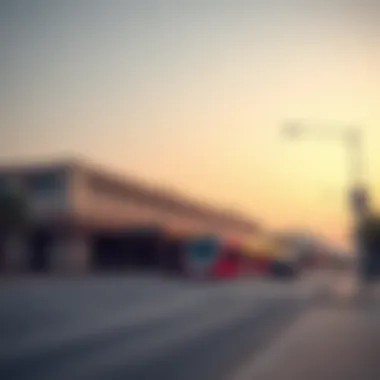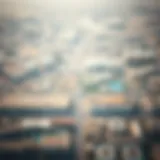Dubai Creek Metro Station: A Hub of Urban Connectivity


Intro
Dubai has quickly transformed into a global hub of innovation and opportunity, and at the heart of this dynamic city lies Dubai Creek Metro Station. It has emerged as a vital cog in the larger machinery of urban transit, facilitating movement across the bustling metropolis. This article aims to unpack the underlying significance of this metro station, exploring its architectural marvel, the surrounding amenities, and its broader influence on the local real estate market. Through this examination, we will highlight how this facility acts as a nexus within Dubai's intricate web of urban mobility.
Market Trends
Dubai Creek Metro Station stands as more than just a transit stop; it encapsulates the vitality of the city's ongoing development. As public transport becomes increasingly pivotal for urban living, understanding its market trends and forecasts is essential for potential investors and residents alike.
Current Market Overview
As Dubai continues to develop, the real estate market shows promising signs of resilience. The area surrounding Dubai Creek Metro Station is no exception. With the influx of residents seeking the convenience that metro access provides, property values around this station have experienced a noticeable uptick.
- Rising Demand: The proximity to the metro station has made nearby properties attractive for rent and purchase.
- Mixed-Use Developments: New projects are emerging that combine residential, commercial, and leisure spaces, catering to the lifestyle needs of modern inhabitants.
- Government Investment: Initiatives to enhance public transport infrastructure often lead to boosted property values in connected areas.
"The metro station isn't just a stop; it's a window into the future planning of a city eager to connect and grow."
Future Predictions and Opportunities
Looking ahead, multiple factors indicate that Dubai Creek Metro Station will continue to be a strong player in the regional transit scene.
- Sustainability Initiatives: As Dubai's 2040 Urban Master Plan unfolds, there's a growing focus on sustainable transport systems. The metro's role in reducing carbon footprints is anticipated to draw more residents.
- Technological Integration: With advancements in smart technologies, the metro system promises improved user experiences. This innovation may lead to increased foot traffic—and consequently, a rise in nearby business activity.
- Evolving Demographics: As Dubai attracts a younger, diverse population, preferences for urban living with easy access to transport systems will drive market values up further.
Investment Strategies
To maximize returns and navigate the property landscape around Dubai Creek Metro Station, savvy investors would do well to consider the following strategies.
Tips for Savvy Investors
- Study the Area: Understanding local amenities—like schools, hospitals, and shopping—is crucial to gauge a property's long-term value.
- Monitor Market Fluctuations: Keeping an eye on market trends will help identify the right time to invest, be it buying or renting.
- Focus on Quality Developments: Investing in high-quality construction projects can secure a more stable return in an evolving market.
Analyzing Property Value Growth
Investors should not only look at current value trends but also delve into historical data to find insights. Examine properties such as:
- Residential Units: Proximity to the metro can lead to stable rental income.
- Commercial Ventures: Businesses benefit from foot traffic resulting from metro station visitors.
Additionally, tracking specific developments or watching for emerging projects can highlight opportunities not yet reflected in the current market prices.
For more insights on urban transit, you might consider reviewing reports from Dubai's Roads and Transport Authority or articles on related trends from Encyclopaedia Britannica. These resources can provide further context and data pertaining to the evolution of Dubai's urban landscape.
Overview of Dubai Creek Metro Station
Dubai Creek Metro Station stands as a fundamental pillar in the city's public transportation framework, making it a topic of significant importance. This station is not just a stop on the Red Line; it encapsulates a broader narrative about urban mobility in a rapidly growing metropolis. Understanding this nexus of transport reveals insights not only into the evolution of Dubai's transit routes but also into how lifestyle, commerce, and real estate are intertwined in a city perpetually on the move.
Historical Context
The inception of Dubai Creek Metro Station can be traced back to Dubai's ambitious vision of becoming a global city. Opened in 2010, this station was part of a long-term plan aimed at easing road congestion and promoting public transport usage among the city's inhabitants. Before this modern marvel, residents relied heavily on private vehicles, which only added to traffic woes. The station’s establishment not only marked a shift towards a more sustainable way of commuting but also reflected historical trends in urban planning that prioritized accessibility and efficiency.
Moreover, the very location of the station over Dubai Creek is symbolic; it bridges not just physical spaces but also the rich cultural history of the Emirate. The Creek itself is a historical artery of trade and transport, underpinning the rise of Dubai as a commercial hub.
Importance in the Metro Network
The significance of Dubai Creek Metro Station extends far beyond its operational capabilities. As a vital junction in the metro network, it connects various neighborhoods and amenities, providing seamless access for commuters. One does not just board a train at this station; they embark on a journey intertwined with broader urban dynamics.
Key Features of Importance:
- Integration: The station seamlessly integrates other transit options, including buses and water taxis. This multi-modal connectivity simplifies commutes, allowing travelers to navigate the city with ease.
- Centrality: Its position in the metro network taps into high-density residential and commercial areas, enhancing its role as an essential commuter hub. The flow of people here reflects the vibrancy of surrounding areas.
- Economic Catalyst: The presence of the metro station is a significant factor in driving local real estate values. The expectation of increased foot traffic has spurred nearby commercial ventures, making it a site for prospective investors.
Architectural Design and Features


The architectural design and features of Dubai Creek Metro Station are not just about aesthetics; they play a pivotal role in shaping urban mobility. This station stands as a testament to the merging of functionality with forward-thinking design, encapsulating the spirit of Dubai’s rapid growth and innovation. The modern skyline mirrors the advancements in urban infrastructure, making the station a key element in enhancing connectivity within the city. The blend of contemporary and traditional elements not only adds charm but also serves practical purposes.
Design Aesthetics
Diving into the design aesthetics of Dubai Creek Metro Station, one cannot help but admire its sleek lines and dynamic forms. The facade showcases a modern yet approachable design, employing glass and steel to offer transparency and openness that invites both residents and visitors. Added to this, the elegant curves of the structure evoke the graceful flow of the nearby creek, establishing a visual harmony with the natural landscape.
Color schemes that reflect the surrounding environment contribute to its aesthetic appeal. The strategic incorporation of local artistry adds a hint of culture, allowing the station to resonate with both inhabitants and tourists, establishing a sense of identity and belonging.
Within the station, the design considerations go hand in hand with user functionality. Spacious waiting areas equipped with comfortable seating ensure that passengers can relax and recharge. Subtle lighting enhances the ambiance, minimizing the harsh glare associated with typical metro systems. The resulting atmosphere promotes a sense of calm and order amidst the hustle and bustle of city life.
Sustainable Practices
Sustainability is at the core of Dubai Creek Metro Station’s design philosophy, reflecting broader environmental strategies adopted by the city. Embracing sustainable practices makes this station not just a hub for mobility but also a model for environmental consciousness in urban design.
- Energy Efficiency: The station utilizes energy-efficient lighting and climate control systems, minimizing energy consumption.
- Water Conservation: Innovative water management systems, including rainwater harvesting and greywater recycling, contribute to lowering the overall environmental footprint.
- Materials: Sustainable materials have been prioritized in construction, aligning with practices that reduce waste and promote recyclability.
By implementing these sustainable strategies, Dubai Creek Metro Station stands as a forward-looking nexus that offers unmatched convenience while being gentle on the planet.
"A transit station is more than just a place for trains and buses; it should inspire movement, connection, and sustainability."
In wrapping up, the architectural design and features of Dubai Creek Metro Station not only fulfill a functional need but also create an iconic landmark that embodies the vision of Dubai's urban landscape. As urban mobility continues to evolve, this station illustrates the essential balance between practicality and design in fostering a vibrant urban workspace.
Connectivity and Accessibility
Connectivity and accessibility are two cornerstones that define the effectiveness of any public transportation system. In the bustling metropolis of Dubai, where the skyline rises high and the streets are often crowded, the Dubai Creek Metro Station emerges as a critical junction. Its strategic location enhances not only the movement of people but also significantly influences local economic dynamics.
Integration with Other Transport Modes
One of the standout features of Dubai Creek Metro Station is its seamless integration with various transportation modes. The station acts as a convergence point for multiple transit systems, including buses, taxis, and water transport. This sort of connectivity facilitates a smoother journey for passengers, allowing them to transition effortlessly from one mode to another.
- Buses: The station is surrounded by several bus stops serviced by the Roads and Transport Authority. This connection enables commuters, especially workers and tourists, to access key areas around Dubai without needing a personal vehicle.
- Taxis: Taxis, which are a popular choice for many, can be found waiting at designated areas around the station, ready to whisk passengers off to their desired destinations.
- Water Transport: Situated along the creek, the station also provides access to marine transport options which connect different parts of the city and offer scenic views, making the commute an enjoyable experience.
In essence, the integration at Dubai Creek Metro Station allows for a holistic approach to urban transport, reducing congestion on roads and promoting the concept of a smart city.
Impact on Traffic Patterns
The introduction of the Dubai Creek Metro Station has considerably altered traffic patterns in the surrounding areas. By providing an efficient alternative to traditional vehicles, this station has contributed to a noticeable decrease in traffic congestion.
- Reduced Travel Time: For many commuters, the metro offers faster travel times compared to road travel, especially during peak hours. This efficiency is crucial in a city where time is often of the essence.
- Encouraging Public Transport Use: With convenient access to the metro, more individuals opt for public transport rather than personal vehicles. This shift not only alleviates road pressure but also promotes a reduction in pollution.
- Urban Development: Changes in traffic flow also catalyze urban development. Areas that were once underutilized begin to thrive as they become more accessible, leading to new businesses, housing developments, and amenities springing up.
"A well-connected public transport system does more than just transport people; it invigorates neighborhoods and fosters economic growth."
Surrounding Neighborhoods
The neighborhoods surrounding Dubai Creek Metro Station symbolize the evolution of urban living in Dubai, where modernity meets tradition. This section explores various facets of these neighborhoods, highlighting their significance for both residents and investors. The area plays a crucial role in the broader context of Dubai's urban layout, shedding light on what makes it attractive for community living and commercial ventures alike.
Demographics and Community
The demographics of the neighborhoods around Dubai Creek reflect a rich tapestry of cultures and nationalities. With residents hailing from various corners of the globe, the area hosts a vibrant community atmosphere. The presence of local markets, schools, and cultural centers enhances the sense of belonging among inhabitants.
Moreover, the blend of expatriates and locals fosters social interaction which is a boon for community engagement. Events organized in public parks or community centers not only promote local culture but also attract diverse participation. Residents often find themselves attending community gatherings that celebrate festivals or food fairs, bringing people together in unique ways.
Investors should note that this diverse demographic is a significant factor in the real estate market, where demand is bolstered by the availability of amenities that cater to various communities.
Commercial Opportunities
An essential characteristic of neighborhoods surrounding Dubai Creek Metro Station is their burgeoning commercial scene. Businesses, ranging from shisha cafes to high-end boutiques, thrive in this area, making it a go-to for both residents and tourists.
The metro station’s convenient location acts like a beacon for investors, as it significantly increases foot traffic to local shops and services. Here are several notable commercial prospects that flourish around this transport hub:
- Retail Shops: Unique boutiques and traditional souks draw both locals and visitors, creating a vibrant shopping environment.
- Dining Establishments: The culinary landscape is rich, ranging from upscale dining options to affordable eateries, catering to varied tastes and budgets.
- Office Spaces: There’s a noticeable demand for well-located office spaces, appealing to startups and established firms alike, which is partly driven by the accessibility afforded by the metro.


This mix of commercial activities presents a solid opportunity for investors looking to capitalize on growing consumer demand.
Residential Developments
The residential landscape around Dubai Creek Metro Station is rapidly changing, reflecting the city's ambitions for growth and modernization. New developments are often designed with community living in mind, incorporating parks and recreational areas that enhance quality of life.
Several key aspects of these residential dwellings include:
- Variety of Housing Options: From luxury condos overlooking the creek to affordable apartments, there’s something for everyone.
- Proximity to Amenities: Many residential developments boast access to schools, hospitals, and shopping centers, making daily life seamless for residents.
- Sustainable Living: There’s a growing trend towards eco-friendly designs, with layouts that prioritize natural light and energy efficiency.
- Community Spaces: Many new projects include communal spaces, fostering neighborly interactions and creating a sense of belonging.
In summary, the neighborhoods surrounding Dubai Creek Metro Station not only exemplify a unique blend of cultural richness and modernity but also represent a fertile ground for commercial investments and residential growth. Understanding these dynamics can inform potential investors about the vast possibilities in this evolving urban landscape.
Real Estate Implications
Understanding the Real Estate Implications surrounding the Dubai Creek Metro Station is vital for investors, businesses, and residents alike. The metro station does not merely facilitate transportation; it triggers a ripple effect in the real estate market. This effect can enhance property values, spur investment opportunities, and call for strategic urban planning. As we navigate through the urban landscape of Dubai, the metro station has emerged as a beacon of growth, drawing in various stakeholders keen on capitalizing on its strategic advantages.
Investment Trends
Investment trends can be quite telling when it comes to gauging the impact of a transportation hub such as the Dubai Creek Metro Station. With its opening, it has paved the way for enhanced investor interest in properties nearby. Investors are increasingly looking at developments that promise both short-term ROI and long-term buy-and-hold strategies. Some of the trends worth noting include:
- Increased Demand: Properties located within close proximity to the metro station have seen an uptick in demand as accessibility becomes a top priority for homebuyers and tenants.
- Commercial Growth: Businesses are strategically aligning themselves near the station due to higher foot traffic and better visibility, which translates to increased revenue opportunities.
- Mixed-Use Developments: There is a noticeable shift toward mixed-use developments which combine residential, retail, and office spaces, thus catering to the diversified needs of the urban populace.
Investors should keep a finger on the pulse of these trends. The greater the visibility and accessibility, the higher the probability of stirring interest from various sectors, including retail, hospitality, and residential.
Property Valuations
The relationship between property valuations and the proximity to a major metro station like Dubai Creek is profound. Properties near the metro often command higher prices due to the convenience they offer.
Key factors affecting property valuations include:
- Accessibility Premium: Properties that boast direct access to the metro line generally see valuations increase by a notable percentage. Commuters value time, and the ability to hop on a train versus being stuck in traffic can drive prices up.
- Urban Development: As new businesses cluster around the metro station, the potential for economic growth becomes evident. This influx of services can elevate property valuations considerably over a short time.
- Market Sentiment: There’s a psychological aspect to property valuations as well. A well-planned metro station fosters community engagement and can uplift market sentiments. These softer factors are sometimes just as significant as data-driven analyses.
Overall, the implications for real estate in the vicinity of Dubai Creek Metro Station are substantive. For investors and real estate agents, staying informed on these trends and valuation factors could make all the difference in decision-making processes. As urban mobility evolves, so too will the opportunities that arise from this pivotal transportation hub.
"In the urban jungle, transport nodes like the Dubai Creek Metro Station act as lifelines, fostering a pulse of real estate rejuvenation."
For further details on the real estate market dynamics in Dubai, consider checking out resources on Dubai's RERA, which provides in-depth insights into property regulations and market trends.
Cultural Significance
The cultural significance of Dubai Creek Metro Station cannot be overstated. This station plays a critical role not only as a transit point but as a nexus of cultural interaction, reflecting the essence of Dubai's rich heritage and its rapid modernization. The proximity to historical landmarks and the heartbeat of local communities makes it a vibrant hub for cultural exchange and social cohesion.
Historical Landmarks Nearby
Nestled close to the metro station are several historical landmarks that tell the story of Dubai's transformation from a small fishing village to a bustling metropolis. A prime example is the Dubai Museum, located in the Al Fahidi Fort. This museum offers a window into the past, showcasing artifacts and exhibits that highlight the rich cultural tapestry of the region.
Additionally, the Sheikh Saeed Al Maktoum House stands as a testament to the architectural styles of the past. Once the residence of Dubai's Ruler, the house is now a museum that attracts tourists and locals alike.
The station’s design incorporates elements that pay homage to these historical sites, blending modernity with tradition. The ambiance here serves to remind commuters that as they travel through this urban landscape, they remain deeply connected to their heritage.
“Public transit is not just about moving people; it’s about shaping communities and preserving history.”
Community Events and Activities
Events around the Dubai Creek Metro Station are aplenty, reinforcing its role as a cultural hub. For example, the annual Dubai Shopping Festival draws massive crowds, with many using the metro for seamless access to various participating outlets. This festival celebrates local and international culture, infusing life into the surrounding neighborhoods.
Moreover, community activities, like the Dubai Creek Festival, showcase traditional music, dance, and art from local artisans, creating a lively atmosphere that welcomes visitors. Such events foster a sense of belonging and pride among residents, bridging gaps and inviting collaboration from diverse backgrounds.
The station's central location makes it an ideal venue for cultural exchange, providing easy access for attendees and encouraging a robust community spirit. Whether it's art exhibitions or cultural fairs, the station has become a pivotal point where diversity meets unity.


Future Developments
The future of Dubai Creek Metro Station is brimming with possibilities, reflecting Dubai’s ambition to remain at the forefront of urban mobility innovations. As the city expands and evolves, planned enhancements can significantly alter how residents and visitors navigate through this vibrant metropolis. Merging seamless transportation with urban design is pivotal, and the forthcoming developments promise to elevate the station's role in fostering connectivity and convenience.
Planned Infrastructure Improvements
A range of improvements is on the horizon for Dubai Creek Metro Station, with a keen focus on integrating cutting-edge technologies into everyday commuting. These developments aren't just about enhancing the station itself; they aim to redefine the overall experience for users.
One crucial improvement includes the addition of smart ticketing systems. By implementing mobile application support, passengers will enjoy a more streamlined journey, reducing wait times and enhancing user satisfaction. Additionally, there’s talk of expanding the platforms to accommodate increased passenger flow during peak hours. This expansion will ease congestion and make for a smoother travel experience.
Further, plans to rejuvenate surrounding areas with integrated transport links are underway. Enhancements such as pedestrian walkways and bicycle parking facilities underscore a commitment to sustainable mobility. These initiatives will encourage residents to opt for eco-friendly transport modes, ultimately contributing to a greener urban landscape.
Impact on Local Economy
With these infrastructure improvements comes the potential for significant economic influence. Enhancing the Dubai Creek Metro Station will serve not only the day-to-day commuter but also attract businesses eager to capitalize on increased foot traffic.
A well-connected station often translates to:
- Increased property values: Areas near enhanced transport links historically see a rise in real estate prices. This rise can be a catalyst for developers and investors to tap into lucrative markets.
- Boosting local commerce: Businesses located near transit hubs can benefit from a larger customer base. The influx of commuters can drive growth in retail, dining, and service industries, feeding a cycle of economic vitality.
- Job creation: Infrastructure improvements typically lead to job opportunities during the construction phase. Once operational, the increased foot traffic may necessitate hiring for various retail operations.
In summary, the planned developments around Dubai Creek Metro Station promise a ripple effect throughout the local economy, extending far beyond mere transit improvements.
With such a potent combination of infrastructure enhancements and economic potential, it's clear that the future developments around Dubai Creek Metro Station will mark a transformative milestone, steering the area towards a more interconnected, prosperous tomorrow.
Challenges and Considerations
The evolution and success of urban transit systems hinge on various challenges and considerations that must be addressed to ensure the smooth operation of public transport hubs like Dubai Creek Metro Station. Understanding these complexities is crucial for stakeholders, including investors, buyers, and agents, as they provide valuable insights into the potential developments and trajectories of urban infrastructure. Here, we will delve into the specific challenges tied to environmental factors and urban planning, exploring how they shape the existing framework and future potential of the metro station.
Environmental Factors
The Dubai Creek Metro Station sits within a region marked by rapid urbanization, prompting critical discussions about its environmental footprint. The desert climate necessitates effective energy use and sustainable practices. Poor environmental management can lead to increased operational costs, so the need for eco-friendly solutions is ever-present.
Several key aspects can be highlighted:
- Energy Consumption: Metro train systems require large amounts of energy, making it vital to invest in renewable energy alternatives. Solar panels, for instance, can be integrated to harness abundant sunlight, thus decreasing reliance on fossil fuels.
- Waste Management: Reducing waste that results from daily operations and ensuring proper recycling methods are in place will help mitigate environmental impacts. Authorities need to implement systems that safely manage waste created in the station and surrounding areas.
- Water Conservation: Given the scarcity of water in the UAE, stations should deploy sustainable technologies, like water-saving fixtures and smart irrigation systems for green areas. These practices can contribute to an overall greener transit system.
By addressing these environmental factors, not only can Dubai Creek Metro Station become more sustainable, but it can also enhance its appeal to eco-conscious investors and community members who prioritize green initiatives.
Urban Planning Challenges
Urban planning presents its own set hurdles that are pivotal for the effective operation of Dubai Creek Metro Station. The interplay between urban design, infrastructure, and community needs can create bottlenecks that often slow momentum in development.
Some challenges include:
- Space Constraints: In a bustling city like Dubai, available land is a precious commodity. Expanding infrastructure can become problematic without careful planning and community engagement. Measures should be taken to integrate developments around the metro station seamlessly to ensure the public has easy access.
- Public Integration: Competing interests from different stakeholders can hinder planning efforts. The station needs to connect with diverse transportation modes, such as buses and taxis, while also considering the horizons of pedestrian accessibility. A unified transport network should be a priority in future planning phases.
- Regulatory Compliance: Navigating through local regulations and obtaining necessary permits can be perplexing for developers. Hence, it’s essential for stakeholders to establish close cooperation with city planners and authorities to avoid setbacks.
In summary, tackling the environmental and urban planning challenges of Dubai Creek Metro Station is not merely a matter of infrastructure but an ongoing dialogue that involves the entire community. Successful navigation of these complexities will yield dividends for investors, ensuring a thriving public transport network integrated into the urban fabric of Dubai.
"To truly innovate in urban mobility, we need to embrace both ecological sustainability and comprehensive urban planning, allowing for a transport system that adapts to the needs of its people."
For further reading on transport sustainability, visit Wikipedia or explore more at Britannica.
Epilogue
The conclusion of this article emphasizes the pivotal role of Dubai Creek Metro Station as a conduit for enhancing urban mobility in Dubai. It encapsulates the myriad factors that contribute not only to the station's significance within the metro network but also its broader implications for the city's growth.
Summation of Key Insights
Multiple threads have woven together to illustrate the importance of this transport hub. Firstly, the architectural design of the station is not merely aesthetic; it reflects Dubai's commitment to modernity while integrating sustainability into its infrastructure. The embrace of eco-friendly practices within the station exemplifies the city's vision for a greener future.
Moreover, connectivity is a cornerstone of this discussion. The station serves as a linchpin that connects various transportation modes. From buses to taxis, the seamless integration of services reduces congestion and fosters a more pleasant commuting experience. Furthermore, the demographic shifts in the surrounding neighborhoods, coupled with the surge in commercial opportunities, underscore how the metro station catalyzes economic growth.
Lastly, the ongoing developments and planned infrastructure improvements point to a dynamic future. Investors looking at property near the station are presented with promising trends in property valuations, which arguably reflect the station's ability to transform the local economy.
Final Thoughts on Urban Mobility in Dubai
Looking ahead, as Dubai continues to expand, the importance of such strategic nodes cannot be ignored. Enhancing public transport systems is a critical step towards addressing challenges like traffic congestion while promoting sustainable living. Embracing these changes is essential for anyone looking to tap into the future potential of Dubai's real estate landscape.
Investors and residents alike can lean into the momentum created by efficient transport links, ensuring that they are not just riding the metro but journeying toward a prosperous future.
"Efficient transport systems form the backbone of thriving urban centers, making Dubai Creek Metro Station more than a mere stop along the line. It’s an experience that transfers urban dreams into reality."
For more insights on urban planning and public transport, refer to Britannica and Wikipedia.







